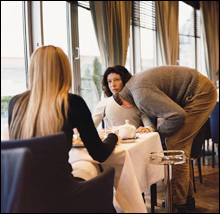
INSPECTION, FROM “INSTRUCTIONS ON HOW TO BE POLITICALLY INCORRECT 2002/2003”: Wurm’s pieces act as mysterious metaphors for our desperate longing for sensual — and mental — connection.
|
Austrian artist Erwin Wurm loves playing the philosopher. When he flew into Boston from his home in Vienna a few Wednesdays ago to give a tour of his retrospective “I Love My Time, I Don’t Like My Time” at Brandeis’s Rose Art Museum, he wondered aloud to the audience, “When I stand quiet, is it a sculpture or is it an action?” He made pronouncements: “Gaining and losing weight is also a sculpture.” You find him testing out such theories in the more than 130 works in this show, which was organized by the Yerba Buena Center for the Arts in San Francisco and is his first major US survey.Born in 1954, Wurm started out working cheap, using whatever materials he had handy. His earliest piece here, the 1992 video 59 Positions, shows him and a friend huddling inside sweaters that they stretch over their bodies in screwball ways, putting their legs into sleeves and so on, to adopt 59 different poses. Mixing clowning and seriousness, he studies the nature of sculpture by seeing how many ways he can vary his presentation of basic objects and by throwing performers into the mix.

He soon hit on his signature idea, the One Minute Sculpture, which began with videos in 1997 and spawned a body of large-format photographs. (It also inspired the video for the Red Hot Chili Peppers’ song “Can’t Stop” in 2002.) These are documents of brief goofy feats of derring-do choreographed by Wurm: a woman lying on the floor with the leg of a chair balanced on her eye; a man on all fours balanced atop coffee cups; a woman holding bottles between her arms and legs; a man balanced on a broom; a woman crushed under a suitcase; two legs of a chair balanced on carrots; a man with a film canisters stuck in his eye sockets, pens plugging his nose and ears, and a stapler in his mouth.
You are invited to have a gallery attendant snap a Polaroid of you improvising your own One Minute Sculpture on platforms Wurm has installed for this purpose. If you send him the photo with $100, he’ll even sign it to make it an official Erwin Wurm artwork. This is one of the oldest and most tired conceptual jokes in the book.
And that’s my problem with this show. Wurm riffs on questions artists have been asking for a century. What makes something art? Who decides? He represents a more knowingly absurd version of those fashion photographers who persuade their subjects to hop into the air or stand in a lake or lie in a tub full of milk. But his art hasn’t the wicked deconstructionist wit of something like Ben Vautier’s Total Art Matchbox from the mid 1960s, a carton of matches with text instructing you to “use these matches to destroy all art . . . and as I Ben signed everything work of art — burn — anything — keep last match for this matchbox.” Neither do his clothing pieces and stunts have the vulnerability and menace of Yoko Ono’s 1964 Cut Piece, in which she sat on a stage with a pair of scissors and invited audience members to snip off her clothes, piece by piece, till she was naked.
A friend of mine says Wurm’s work is about human isolation. Perhaps that’s why my favorite Wurm photos depict awkward acts of physical intimacy: a man on a street putting his hand in another guy’s mouth; a woman in a restaurant sticking her hand down the fly of her jeans; a man in a restaurant shoving his head down the front of a woman’s shirt; two standing women pressed together trapping a bunch of oranges between their bodies; a woman lying atop a man on a city sidewalk. Several of these come from his 2003 series “Looking for a Bomb,” and they touch on the sacrifice of privacy in the name of security, but at a basic level they seem mysterious metaphors for our desperate longing for sensual — and mental — connection.
Wurm packs many of his concerns into Fat House (2003), a doughy-looking two-story-tall cottage bulging out from under its red roof. On one hand, it’s a satire of wealth and excess, but in the darkened interior there plays an animation of the cottage worrying about the nature of its existence. “Am I an artwork? I am a house, yes, but if someone would want to buy me, what would they get? A house and an artwork? Just a house? Or a double house?” The cartoon rambles on in a female flat-affect voice. “Oh, that’s so confusing. And why am I fat? A house cannot be fat.”